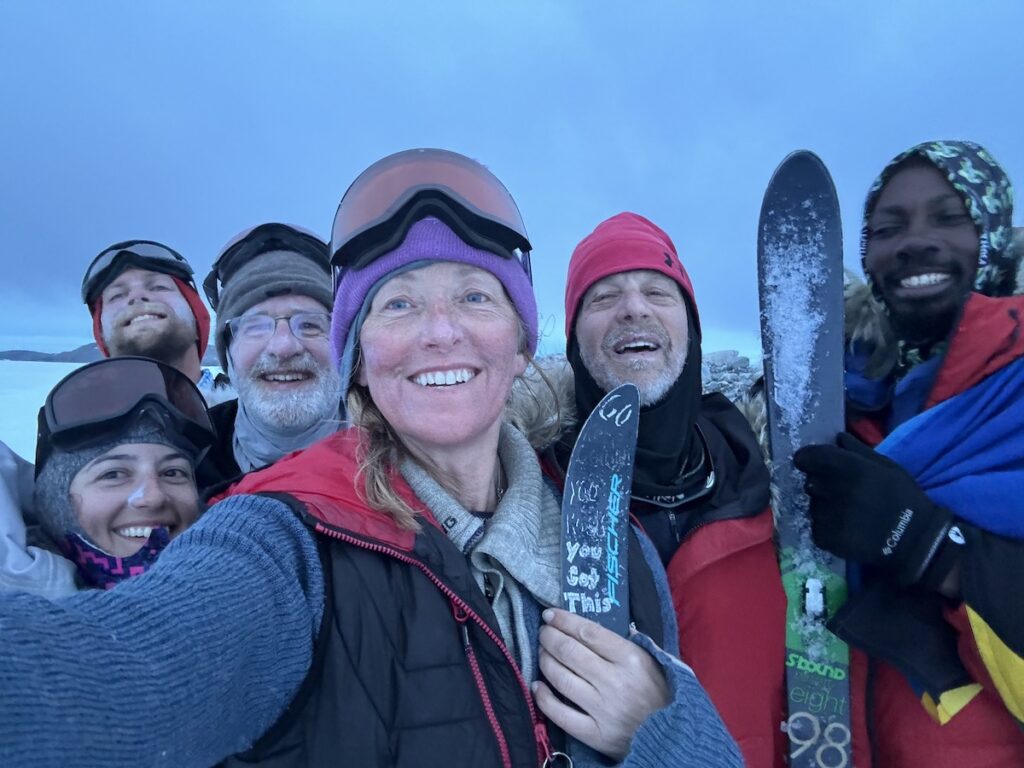
How a tire got a Wilmette woman across Greenland
After spending seven months dragging a tire — sometimes two — across the North Shore, including the beach and Green Bay Trail up to Highland Park, in preparation for an expedition traversing the Greenland Ice Sheet, Wilmette resident Annie Aggens has heard it all.
Community members regularly stopped her during her training to share jokes, she told The Record, with some of the most popular one-liners being, “You know those [tires] are supposed to roll, not drag” and “Hey, you need a lift? My tires are all working.”
But it was all in good fun, and this very public training gave Aggens the opportunity to interact with her neighbors, learn about their adventures and tell them about Greenland, why its ice sheet is so important and the expedition Aggens and a co-worker would lead beginning on April 23.
Aggens is the director of PolarExplorers, the Wilmette company that led the first-ever commercial North Pole Dogsled Expedition in 1993 and now organizes guided expeditions around the globe in some of the most remote and harsh yet beautiful locations.
So, Aggens is no stranger to traversing landscapes under difficult conditions, but her spring 2024 adventure was unlike any other.
“I’ve found that no job is as satisfying as taking people out into these places where they can learn so much about the world, themselves and each other.”
Annie Aggens, director of PolarExplorers
On a previous expedition to Greenland, Aggens and other PolarExplorers participants worked with Greenlandic mushers, crossing the Greenland Ice Sheet by ski with dog sled support.
For this recent trip, each of the seven participants (Aggens, her co-guide and five others from around the world) carried 30 days worth of supplies, such as food, fuel and other necessities, in individual sleds strapped to them with harnesses. (PolarExplorers also led a separate group with three participants making the same journey that began only one day prior.)
Aggens and her group left for Greenland on April 23 and spent a few days making preparations for the expedition before being transferred to the Ice Sheet on May 1. During this time, the group was approached by a Greenlandic man who began telling them about the significance of the Greenland Ice Sheet, which those native to Greenland call “The Big Ice.”
The nickname is fitting. This single ice sheet covers about 80 percent of Greenland. It is the largest mass of ice in the Northern Hemisphere and is the second largest globally, behind only the ice mass that covers Antarctica.
According to scientists at NASA and the National Oceanic and Atmospheric Administration, the Greenland Ice Sheet is melting at an unprecedented rate, causing rising sea levels and an influx of fresh water entering the oceans and changing the salinity, which could impact weather patterns and ecosystems.

The Greenlandic man who told the group about “The Big Ice” then recited a blessing for The Big Ice for them.
“He sang this song that was more like a chant, and it was really loud, and at the end of it, he was kind of like ‘ahhhhh,’” Aggens said as she mimicked the note. “And then he went ‘aah,’ Aggens let out a small exhale in her reenactment, “and he used his hands [to trace] the [exhaled] air up into the greater air. That was super significant for us to know that we were traversing a place that, for climate reasons, is so significant but is also so sacred to the people of Greenland.”
In 1888, Norwegian explorer Fridtjof Nansen, alongside five companions, was the first person to cross Greeenland’s ice cap on skis within six weeks. Fast forward to just months ago, and Aggens and her group had the goal of traveling approximately 14 miles per day to finish their journey within 30 days (and that wasn’t even at the widest point of the ice cap).
As they traveled along what Aggens refers to as the “spine” of Greenland from North to South, they weren’t able to reach that 14-mile goal as they were moving along a ridge with a height, at its peak, of 8,300 feet. Upon passing this summit, they began moving generally downhill and could pick up their pace.
The group allowed Greenland’s fickle weather to determine when they would rest. Though the wind obligated them to take a couple half-days of rest toward the end of the expedition, they still skied every day for 30 straight days.
“Out there, I felt really strong,” Aggens said. “I felt really excited and motivated, actually, even with a heavy sled. We were working so hard. We were working from the moment our eyes opened in the morning; even getting out of bed is work, and starting the stove and then melting the snow into water so that you can put it into your oatmeal and make yourself a hot cocoa or a coffee.”
Aggens described eating as work, too. She tried to maintain a diet of 4,600 calories a day, requiring her to add butter to her hot cocoa and her meals. Sometimes, she said, it was so cold and their face masks froze, making it extra work just to stop and eat or drink.

Camaraderie helped get them through the long days.
“Even though I felt strong, I still had hard days,” Aggens tells The Record. “But there’s a difference between feeling like you’re overwhelmed and just being tired and having a hard day. I think that everybody probably felt overwhelmed sometimes and probably felt like they were at their limit sometimes, but in general everyone had just an amazing attitude and were super resilient and … strong and supportive of each other.”
The months of preparation leading up to the expedition were necessary, with Aggens noting that cross-training and balance training were important. Balance training helped Aggens learn to navigate whiteouts in which both the sky and snow are the same color, causing disorientation and making it difficult to see as though, Aggens said, “you’re in a ping pong ball.”
But according to Aggens, the most important part of her training was pulling tires across town in preparation for the sled she would have to tug across the Greenland Ice Sheet. She trained on different surfaces, such as sand, to get a sense of what different conditions and different levels of friction would feel like along the expedition route.
Her training time ranged from an hour or two to eight or nine hours.
That preparation, she said, allowed her to go out to Greenland and say to herself, “I got this. I’ve done this a few times. Yeah, my body recognizes this. This is exactly what it felt like to be pulling to Highland Park and back.”

Aggens valued running into community members during her training sessions and getting to exchange stories with them, especially because she said she’s found that it’s so easy for people to “disassociate from the natural world” in their busy lives, yet it’s important to think about “intentionally reconnecting” with nature. Sharing stories with each other within the community, even during casual run-ins, can serve as a step in this reconnecting process.
For Aggens, these expeditions and adventures continually enrich how she experiences the world.
“I’ve found that no job is as satisfying as taking people out into these places where they can learn so much about the world, themselves and each other,” Aggens said.
The Record is a nonprofit, nonpartisan community newsroom that relies on reader support to fuel its independent local journalism.
Become a member of The Record to fund responsible news coverage for your community.
Already a member? You can make a tax-deductible donation at any time.

Zoe Engels
Zoe Engels (she/her) is a writer and translator, currently working on a book project, from Chicagoland and now based in New York City. She holds a master's degree in creative nonfiction writing and translation (Spanish, Russian) from Columbia University and a bachelor's in English and international affairs from Washington University in St. Louis.


